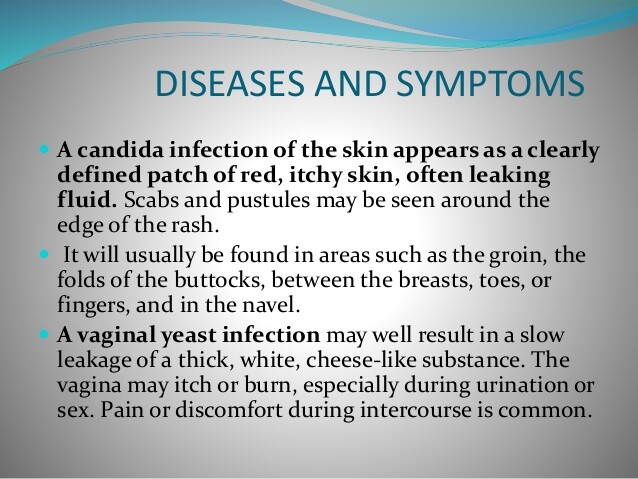Clinical Findings
Signs and Symptoms
Skin infections with Candida are common and may manifest in a variety of forms. Intertrigo occurs in warm, moist areas of skin, such as under the breast, in the groin, and in the axilla. Initially pustular or vesicular, lesions eventually become confluent to form an erythematous, macerated area of skin with a scalloped border and satellite lesions (Box 1). Erosio interdigitalis blastomycetica is similar to intertrigo but involves the areas between the fingers and toes. Paronychia is infection of the nail bed, seen more commonly in diabetics and people who frequently immerse their hands in water. Candida spp. may cause onychomycosis, particularly in HIV-infected patients. Candida spp. cause a rash in neonates in the region of diaper contact. Other common skin manifestations include folliculitis, balanitis, perianal candidiasis, and a generalized cutaneous eruption with widespread lesions resembling intertrigo that spread to involve the abdomen, chest, back, and extremities.
Chronic mucocutaneous candidiasis (CMC) is an abnormality of cell-mediated immunity that presents with recurrent infections of the skin and mucus membranes that may progress to disfiguring lesions (Candida granulomas) despite antifungal therapy. Symptoms usually begin in the first several years of life. CMC is associated with autoimmune endocrine failure, particularly hypoparathyroidism and adrenal insufficiency (polyglandular autoimmune syndrome type I), and endocrine disease often presents years to decades after the onset of CMC.
Cutaneous lesions may be superficial evidence of disseminated candidiasis and candidemia. Lesions are typically red or pink nodules 5-10 mm in diameter and may be single or widespread. Lesions resembling ecthyma gangrenosum or purpura fulminans have also been described.
Laboratory Findings
Candida organisms, seen as budding yeast and hyphae, may be present on wet mount or KOH preparations of skin scrapings. Biopsy specimens may reveal characteristic fungal elements on histology.
Differential Diagnosis
Candida infection of the skin and nails may be confused with other infections, both fungal and nonfungal, as well as noninfectious conditions such as contact or allergic dermatitis.
Complications
Candida infection of the skin and nails may cause discomfort and disturb cosmetic appearance of the skin but does not usually cause long-term sequelae. CMC may progress to cause large disfiguring lesions.
Diagnosis
Diagnosis of Candida infection involving the skin or nails is generally made by recognition of the clinical pattern followed by demonstration of fungal elements on a KOH preparation of skin scrapings. Candida infection may also be diagnosed by microscopic examination of biopsy specimens. Culture of the skin should be interpreted with caution, as the presence of Candida spp. may represent colonization rather than infection.
Treatment
Treatment of Candida skin infections is generally straightforward. Intertrigo is managed by decreasing moisture in infected areas and by application of topical antifungal therapy. Nystatin cream, topical azoles (miconazole, clotrimazole), and amphotericin B cream are all effective when applied 2-3 times daily. Paronychia may be treated by keeping the area dry and with topical antifungal therapy. Onychomycosis requires several months of treatment with oral azoles, such as itraconazole, or terbenifine. Relapses may occur. Griseofulvin is not active against Candida.
CMC is treated with oral ketoconazole or fluconazole. Transfer factor, an immunomodulating factor composed of a cell-free leukocyte extract, was used in the past but has fallen out of favor because of lack of efficacy. Months to years of treatment are generally required.




